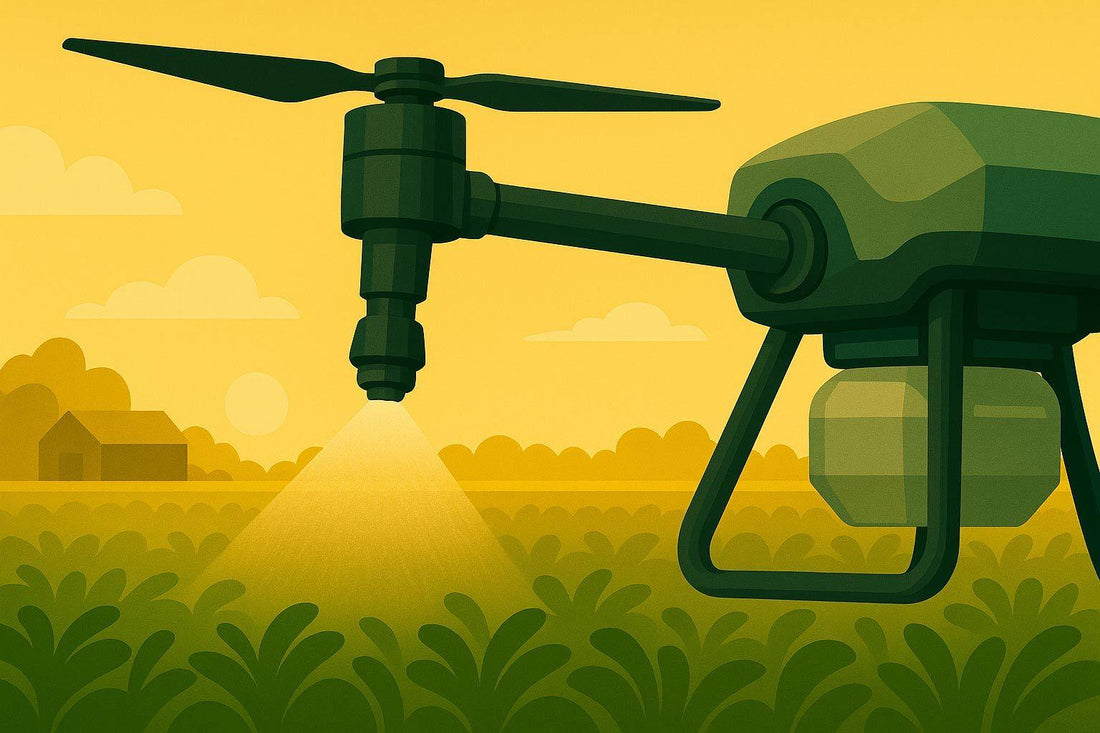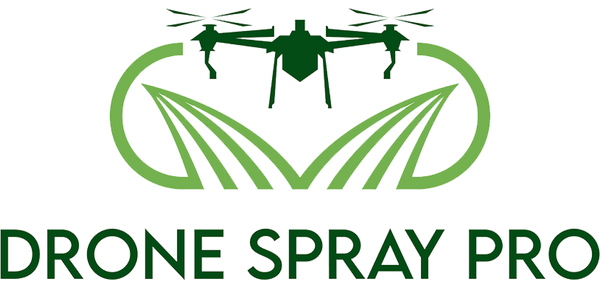
How Nozzles Turn Agricultural Drones into Precision Sprayers
Share
Why the Smallest Part on Your Sprayer Drone Drives the Biggest ROI
When growers picture agricultural drones they usually think about carbon‑fiber frames and RTK flight paths, yet the nozzle is the component that converts liquid into yield. The right tip keeps chemicals on target, protects beneficial insects, and stretches every tank load across more acres. RTK technology provides centimeter‑level accuracy, reducing chemical overlap. That precision only pays off if each droplet falls within the label’s droplet spectrum, which starts with the nozzle.
The Three Nozzle Families That Rule the Sky
| Nozzle Type | Common Spray Angle | Droplet Band (µm) | Ideal Use Case | Drone Examples | Pros | Cons |
|---|---|---|---|---|---|---|
| Flat Fan | 110–120 deg | 250–400 | Broad‑acre herbicide and foliar nutrient work | DJI Agras T40 OEM XR tips | Uniform sheet pattern, easy overlap | Higher drift risk in windy conditions |
| Air‑Induction Flat Fan | 80–110 deg | 350–550 | Dicamba, 2‑4‑D, or other drift‑sensitive chemistries | XAG P1000 DR series | Coarse, air‑filled drops reduce drift | Slightly lower leaf coverage |
| Centrifugal Atomizer | N/A (disc) | 130–300 | Powdered fertilizers, biologicals, specialty crops | DJI dual‑spinner upgrade | Plug‑resistant, fine uniform mist | Added cost, requires power draw |
Flat fan and air‑induction tips ship with nearly every sprayer drone because they balance coverage with efficiency. Centrifugal heads, launched on the Agras platform in 2024, spin liquid between twin discs, eliminating the narrow orifice that causes plugging.
Droplet Physics Made Simple
Atomization begins in the pre‑orifice, where pressure turns liquid into a thin sheet or rotating film before it exits the discharge face. Field tests on soybeans kept at 40 psi show flat fan tips delivering a Volume Median Diameter (VMD) of 300 µm, well inside EPA’s medium droplet class.
“Stay between 250 and 400 microns for herbicides; coarser if drift buffers are tight, finer if you need canopy penetration,” advises Dr. Elise Moran, Crop Technology Specialist at Drone Spray Pro.
Maintaining pressure within ±2 psi keeps the Coefficient of Variation below 10 percent, the industry line for even coverage
sbb-itb-3b7eef7
RTK and Flight Geometry: Locking the Pattern in Place
Precision droplets still miss the mark if the aircraft wanders. Our in‑house trials pairing 110‑degree flat fans with RTK flight paths showed a five‑percent chemical savings compared with WAAS guidance, confirming the RTK findings above. Explore hardware choices in the Top 6 RTK Systems list for gear that integrates seamlessly with DJI, XAG, and Hylio airframes.
Nozzle Type Comparison
Studies demonstrate that full cone nozzles provide more consistent coverage, ensuring effective distribution of pesticides and nutrients across crop canopies. These results align with earlier performance metrics, particularly in meeting target VMD ranges and maintaining low variation rates under field conditions.
Using Full Cone Nozzles on Drones
Drones equipped with full cone nozzles bring a new level of efficiency to precision farming. By pairing these nozzles with modern drone systems, farmers can achieve better spray uniformity while improving overall operational efficiency.
Best Practices for Drone Spraying
Achieving consistent spray coverage requires careful control of flight parameters. Factors like altitude and speed play a key role in ensuring even distribution.
Key parameters for effective spraying:
| Parameter | Recommended Range | Impact on Coverage |
|---|---|---|
| Coverage Rate | 40–60 acres/hour | Influences application efficiency |
| Flight Duration | 10–15 minutes | Reflects typical battery life |
| Flight Height | 6–12 feet | Affects spray width and precision |
| RTK Accuracy | Centimeter-level | Reduces overlap and waste |
RTK (Real-Time Kinematic) systems are essential for maintaining precise flight paths, helping to minimize chemical waste and improve efficiency. Alongside these parameters, equipping your drone with the right tools is just as important.
Nozzle Care and Battery Savvy: Two Pillars of Uptime
| Maintenance Task | Frequency | Time Needed | Resource |
|---|---|---|---|
| Rinse spray lines and nozzles with clean water | After every load | 3 min | “Clogged Spray Nozzles” in 7 Common Spray Drone Problems |
| Back‑flush and visually inspect tips for wear | Weekly | 10 min | Step‑by‑step visuals in 10 Essential Maintenance Tips |
| Replace ceramic or stainless inserts | Every 400–500 hours | — | See OEM manual |
| Store batteries at 40–60 percent charge | End of season | — | Ultimate Guide to Drone Battery Management |
Batteries drive pump pressure and rotor RPM, both of which affect droplet size. Cold temps can chop flight time by 25 percent, so pre‑warming packs in an insulated case pays dividends
Do You Need to “Choose” a Nozzle?
Most ready to fly packages arrive calibrated to the aircraft pump and expected GPA. Situations that justify a swap:
- High‑value tree fruit needing deeper penetration, where a full cone can shine.
- Drift‑sensitive chemistries like dicamba, which favor coarse air‑induction tips.
- Dry formulations that atomize better through centrifugal heads.
Always validate GPA after any change using a patternator or water‑sensitive card grid at the target height.
Drone Spray Equipment Essentials
Choosing the right equipment, such as advanced RTK systems, reliable batteries, and proper licensing, enhances the benefits of the precision that sprayer drone nozzle provide. Drones like the DJI Agras series are a great example, offering advanced spray technology paired with these nozzles.
Key equipment to consider:
- Multiple Batteries and RTK Systems: Ensure continuous operation and precise, targeted spraying.
- Licensing: Obtain an FAA Part 107 Commercial Drone License and any required state permits for agricultural spraying.
- RTK Integration: Use precision positioning systems to maintain accurate coverage patterns and reduce waste.
Farmers in southeast Idaho can take advantage of hands-on demonstrations to see spray drones in action. These sessions provide practical insights into nozzle performance and help optimize spray patterns for real-world conditions.
Steps Farmers Can Take
To achieve better spray uniformity, consider these actionable steps for your farm operations:
- Get the Right Licenses: Obtain the FAA Part 107 Commercial Drone License and any necessary agricultural spray permits.
- Use RTK Technology: Install precision positioning systems to ensure accurate and efficient spray patterns.
- Fine-Tune Flight Settings: Adjust the height and speed of flights to minimize uneven spray coverage.
FAQs
How do air‑induction nozzles on spray drones reduce drift without sacrificing efficacy?
Air‑induction (AI) tips pull ambient air into the liquid stream through a Venturi cavity, creating coarse, air‑filled droplets that are heavier than those from a standard flat fan. The added mass resists lateral wind shear and rotor downwash, so fewer particles linger in the “drift‑prone” 100 µm zone. Field wind‑tunnel trials at 10 mph showed AI11004 tips cutting detectable off‑target deposition by nearly 70 percent while maintaining 90 percent weed‑control efficacy in soybeans. To retain leaf‑surface coverage, pilots should:
Increase pressure by 5–8 psi over a comparable flat‑fan setting to push droplets into the medium (300 µm) class.
Fly two feet lower than normal (often 8 ft AGL) so the wider 80–110 degree pattern still overlaps correctly.
Keep ground speed under 7 mph if wind exceeds 8 mph.
What flow‑rate and nozzle size yield a true 2 GPA application on a DJI Agras T40?
Start by converting gallons per acre to gallons per minute: 2 GPA × (flight speed in mph) × swath width (ft) ÷ 495. A T40 running XR11002 tips at 18 mph and a 30 ft swath needs roughly 2.2 GPM total, or 0.55 GPM per nozzle. The XR11002 delivers 0.52 GPM at 40 psi, so you can:
- Set pump pressure at 42 psi to hit 0.55 GPM.
- Program ground speed to 18 mph and lock altitude at 10 ft for full overlap.
-
Validate spray volume by catching each nozzle output for 60 seconds; adjust speed if flow deviates more than 3 percent.
If you swap to an AI11003, expect flow to jump to 0.66 GPM at the same pressure; reduce speed to 14 mph or narrow the swath to hold 2 GPA.
How often should I calibrate or replace spray‑drone nozzles, and what tests confirm they’re still accurate?
Calibration frequency depends on flight hours, chemistry, and tip material:
- Ceramic or stainless tips: bench‑test every 50 spray hours and replace at 400–500 hours or once flow drift exceeds ±5 percent of new‑tip specs.
-
Polymer tips: bench‑test every 30 hours and replace at 250 hours or sooner if edges show wear.
Three validation tools keep patterns in spec:
- Patternator tray grid – captures distribution; CV should stay under 10 percent.
- Water‑sensitive paper – place at canopy height every 3 ft; target 40 percent stain coverage for systemic products.
-
Catch‑can flow test – run a 60‑second timed catch at operating pressure; compare to factory flow charts.
Always follow a “clean water–chemical–clean water” rinse cycle to flush residues that accelerate wear and skew calibration results.
